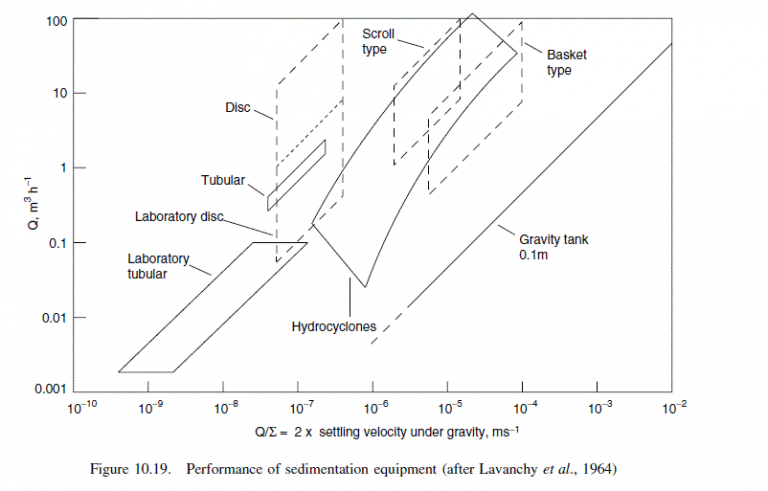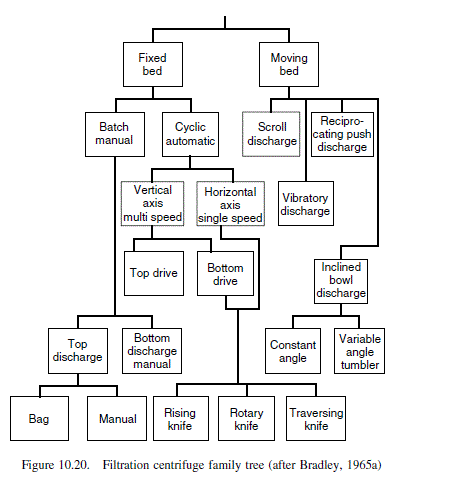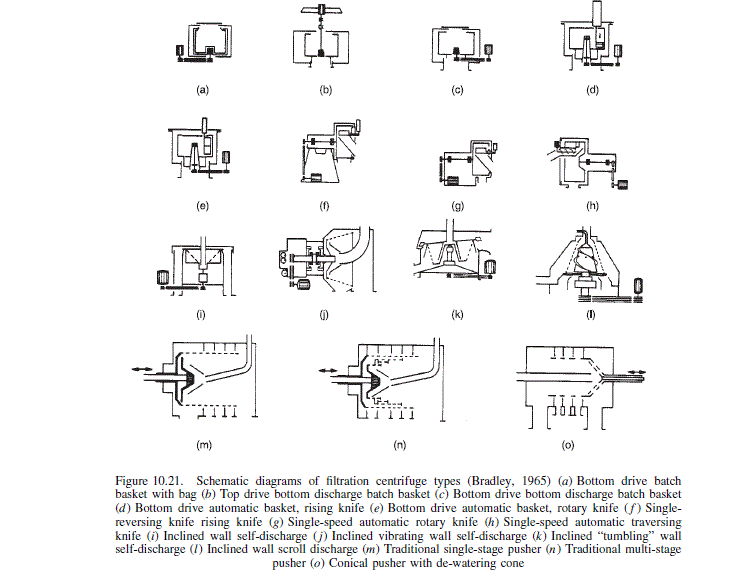A precipitate is to be continuously separated from a slurry. The solids concentration is 5 per cent and the slurry feed rate 5.5 m ^{3} / h. The relevant physical properties at the system operating temperature are:
\text { liquid density } 1050 kg / m ^{3} \text {, viscosity } 4 cp \left( mNm ^{-2} s \right) \text {, } \text { solid density } 2300 kg / m ^{3} \text {, "cut-off" particle size } 10 \mu m =10 \times 10^{-6} m \text {. }Question 10.1: A precipitate is to be continuously separated from a slurry....
The Blue Check Mark means that this solution has been answered and checked by an expert. This guarantees that the final answer is accurate.
Learn more on how we answer questions.
Learn more on how we answer questions.
\text { Overflow rate, } Q=0.95 \times 5.5=5.23 m ^{3} / h =\frac{5.13}{3600}=1.45 \times 10^{-3} m ^{3} / s
\Delta \rho=2300-1050=1250 kg / m ^{3}
From equations 10.1 and 10.2
Q=2 u_{g} \Sigma (10.1)
u_{g}=\frac{\Delta \rho d_{s}^{2} g}{18 \mu} (10.2)
\frac{Q}{\Sigma}=2 \times \frac{1250\left(10 \times 10^{-6}\right)^{2}}{18 \times 4 \times 10^{-3}} \times 9.81=3.4 \times 10^{-5}
From Table 10.6 for a Q \text { of } 5.23 m ^{3} / h \text { at a } Q / \Sigma \text { of } 3.4 \times 10^{-5} a solid bowl basket type should be used.
type should be used. To obtain an idea of the size of the machine needed the sigma value can be calculated using the efficiency value from Table 10.6.
| Table 10.6. Selection of sedimentation centrifuges | ||
| Type | Approximate efficiency (%) | Normal operating range Q , m ^{3} / h \text { at } Q / \Sigma m / s |
| Tubular bowl | 90 | 0.4 \text { at } 5 \times 10^{-8} \text { to } 4 \text { at } 3\times10^{-7} |
| Disc | 45 | 0.1 \text { at } 7 \times 10^{-8} \text { to } 110 \text { at } 4.5\times 10^{-7} |
| Solid bowl (scroll discharge) | 60 | 0.7 \text { at } 1.5 \times 10^{-6} \text { to } 15 \text { at } 1\times 10^{-5} |
| Solid bowl (basket) | 75 | 0.4 \text { at } 5 \times 10^{-5} \text { to } 4 \text { at } 1.5 \times 10^{-4} |
From equation 10.1:
\begin{aligned}\Sigma=\frac{Q}{e f f . \times 2 u_{g}} &=\frac{1.45 \times 10^{-3}}{0.75 \times 3.4 \times 10^{-5}} \\&=56.9 m ^{2}\end{aligned}
The sigma value is the equivalent area of a gravity settler that would perform the same separation as the centrifuge.
Filtration centrifuges (centrifugal filters)
It is convenient to classify centrifugal filters into two broad classes, depending on how the solids are removed: fixed bed or moving bed.
In the fixed-bed type, the cake of solids remains on the walls of the bowl until removed manually, or automatically by means of a knife mechanism. It is essentially cyclic in operation. In the moving-bed type, the mass of solids is moved along the bowl by the action of a scroll (similar to the solid-bowl sedimentation type); or by a ram (pusher type); or by a vibration mechanism; or by the bowl angle. Washing and drying zones can be incorporated into the moving bed type.
Bradley (1965) has grouped the various types into the family tree shown in Figure 10.20.
Schematic diagrams of the various types are shown in Figure 10.21. The simplest machines are the basket types (Figures 10.21a, b, c), and these form the basic design from which the other types have been developed (Figures 10.21d to o).
The various arrangements of knife mechanisms used for automatic removal of the cake are shown in Figures 10.21d to h. The bottom discharge-type machines (Figures 10.21d, e) can be designed for variable speed, automatic discharge; and are suitable for use with fragile, or plate or needle-shaped crystals, where it is desirable to avoid breakage or compaction of the bed. They can be loaded and discharged at low speeds, which reduces breakage and compaction of the cake. The single-speed machines (Figures 10.21f, g, h) are used where cakes are thin, and short cycle times are required. They can be designed for high-temperature and pressure operation. When continuous operation is required, the scroll, pusher, or other self-discharge types are used (Figures 10.21i to o). The scroll discharge centrifuge is a low-cost, flexible machine, capable of a wide range of applications; but is not suitable for handling fragile materials.
It is normally used for coarse particles, where some contamination of the filtrate with fines can be tolerated.
The capacity of filtration centrifuges is very dependent on the solids concentration in the feed. For example, at 10 per cent feed slurry concentration 9 kg of liquid will be centrifuged for every 1 kg of solids separated; whereas with a 50 per cent solids concentration the quantity will be less than 1 kg. For dilute slurries it is well worth considering using some form of pre-concentration; such as gravity sedimentation or a hydrocyclone.



Related Answered Questions
\text { Flow-rate }=\frac{10 \times 10^{3}}...
As 30 per cent of the particles are below 10 μm th...
From steam tables, at 4 bar: saturation temperatur...